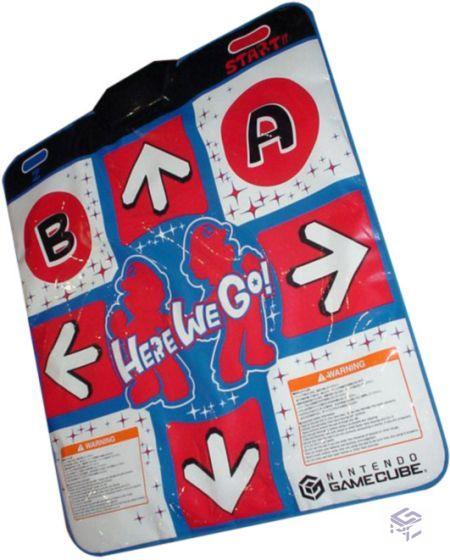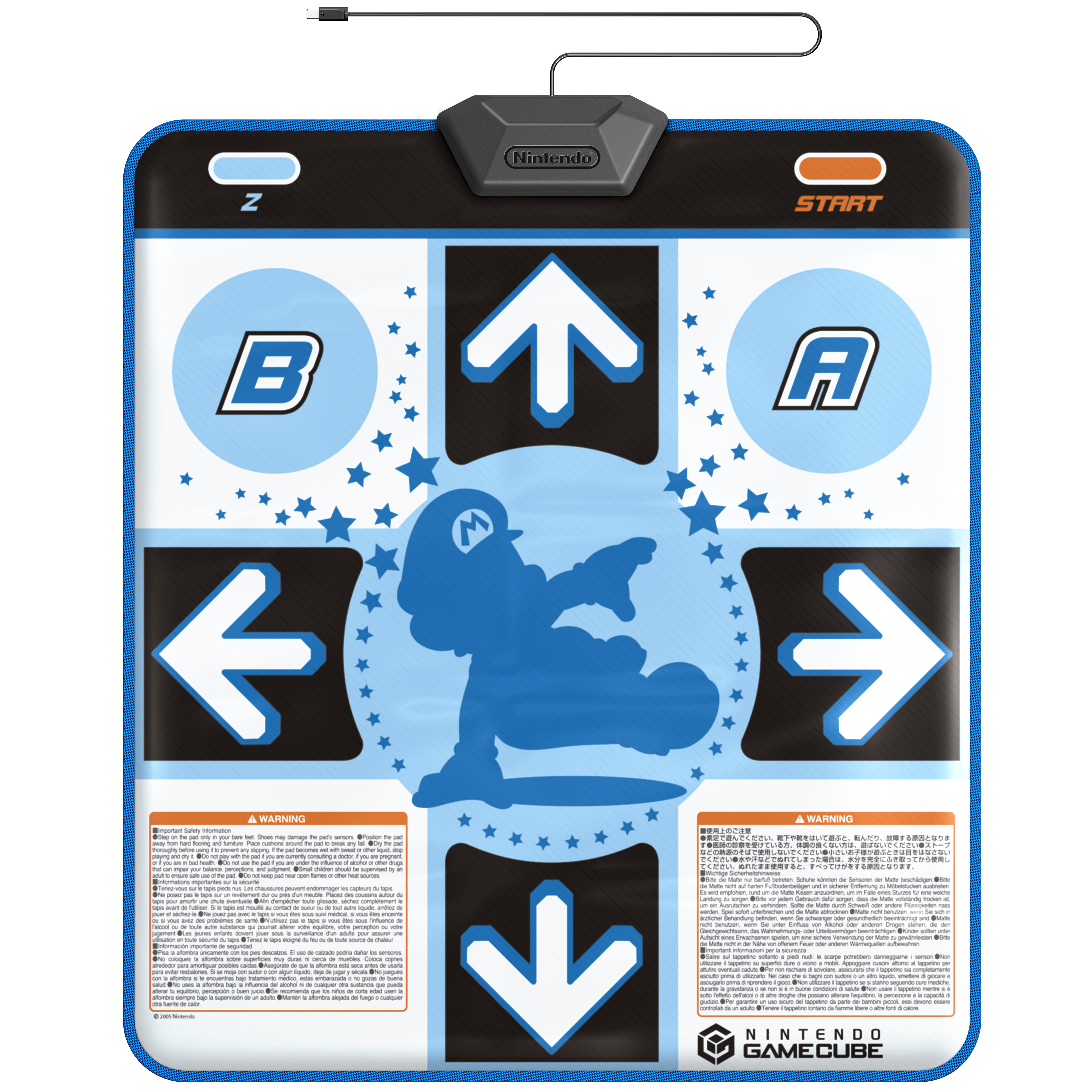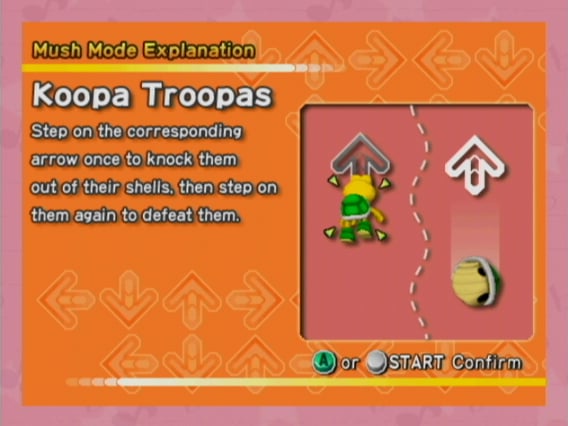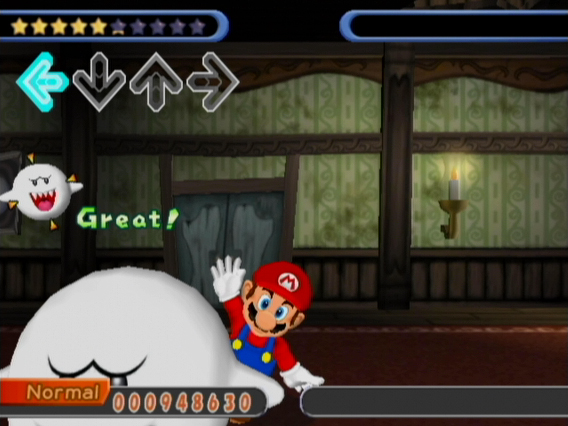Dance Dance Revolution: Mario Mix
Dance Dance Revolution: Mario Mix (also called DDR with Mario) is a Nintendo GameCube game that utilizes an included Mario-themed dance mat. To play the game, players must step on the up, down, left, and right arrows when they line up with a bar on the screen. The player can choose to play with either Mario or Luigi in a number of modes and difficulty levels with nearly thirty songs.
Mario Mix is the second dancing game to come out on the GameCube (the first had poor songs and lacked good on-screen cues). However, seasoned DDR fans have found the game easy, with Super Hard mode simply being a "standard" dance in other games (though some songs are considered "heavy" at the end, especially Bowser's Castle).
How to Play
Included with the game is a dance mat (or as Konami calls it, an action pad) which plugs into a controller socket on the GameCube. Then, standing in the center of the mat, you simply step on an arrow when it reaches the top of the screen: left, right, up or down. Of course, as the difficulty rises, moves such as jumps to step on two arrows at the same time will be required, and eventually staying in the center will actually hurt you when you must move around the mat quickly.
Incidentally, the game can be sold by itself without a dance mat. The regular controller then uses the D-pad, the joint stick, or B for left, X for right, Y for up, and A for down.
Dance Meter
At the start of each song, a dance meter appears in the upper left corner. It consists of ten stars, with each song starting with five (this can be varied with items). As you get Perfects and Greats, the meter rises. When you miss, it decreases. In the Options menu, you can set how much a miss decreases your dance meter, and in Story Mode the higher the difficulty, the more you lose. The meter will flash if you are under two and a half stars, and when the dance meter runs out of stars, the song will end automatically and you will get an F for the song and a 'Failed' message (and you’ll lose a life in Story Mode!).
Grades for the Song
When you keep your dance meter filled and get a Cleared! message at the end of the song, these are the possible grades:
- A - Can I call you a dancing master? Top grade. A couple, if not any missteps.
- B - You're a fantastic dancer! You should dance one more time! A very good grade with very few missteps.
- C - Bravo! A fair grade with some missteps.
- D - Excellent! A significant amount of missteps.
- F - Wha-wha what? A ton of missteps leads to this dreaded grade, even if you clear the song.
Two major factors decide your grade for a song: number of missteps in relation to the song length and total points. As the difficulty rises, more missteps can still mean a better grade (B), but the A still requires barely any missteps.
Grades for Each Step
Each step you make gets a grade that affects your overall score, by giving points per step:
- Perfect: You hit the step right on the mark. Max points for step.
- Great: Also known as Super. You almost got it! Half the max points for step.
- Early/Late: You missed by a bit. No points, dance meter stays the same.
- Miss: You didn’t step on the arrow at all! No points, dance meter decreases.
Getting Perfects and Greats not only increases your dance meter, it adds a combo on-screen. When you get a 100 combo, the announcer will comment and arrows will flash differently when you step on them. A combo stops if you do a misstep (Early, Late or Miss).
Difficulties
Easy: only includes left and right arrows. Perhaps the easiest level in any DDR game.
Normal: basic steps. This is where you learn to get your footing!
Hard: steps get near 200 at times. Common patterns appear in step sequences.
Very Hard: number of steps from 125 to over 200 in some spots. Complicated patterns occur that require shuffling of feet and moving off the center.
Super Hard: over 200 steps in each song. Bowser’s Castle (song) has 339 steps. Offbeat steps require careful timing.
In Story Mode, the player can choose every difficulty except Super Hard at the beginning of the adventure and it stays permanent throughout all the songs. It can only be changed by a Music Wand.
Dance-Offs
Two players, one as Mario and the other as Luigi, can face off in any song to see who is better, at any difficulty like Free Mode. Be warned, though: the initial package comes with only one dance mat. A second one must be ordered online at Nintendo’s official website.
Modes
- Story Mode: Waluigi has stolen the Music Keys from Truffle Towers! Toad will accompany the brother of your choice in this adventure.
- Free Mode: All the songs you play in Story Mode are unlocked in this mode, where you can play any song you want at any difficulties, Mush Mode on or off.
- Minigames: These will unlock themselves as you play Story Mode. A list of these can be found later in the article.
- Workout: Enter your name, weight, and the number of calories burned will be kept on record! Before you start Story or Free Mode, press Z to set whose records will be added on to.
Songs (Media)
To see a listing of the 29 songs in this game, click here.
Mush Mode
Mush Mode is the Mario twist to the DDR genre. Common Mario enemies and items replace steps on the screen and must either be stepped on or avoided. Others cover the screen when you miss steps, giving the brothers less time to react. Mush Mode is enforced in Story Mode and optional in Free Mode. On the hardest difficulties, two Mush Mode effects is not uncommon.
Goombas - Just like regular arrows, squash them.
Koopa Troopas – Step on it once to put it in its shell, then once more to either a) destroy it or b) send it down the screen to destroy a step. The game decides which effect occurs.
Bob-ombs – Podoboos replace steps and when a brother misses one, it hits a bomb, greatly decreasing his dance meter! In dance offs, Podoboos are passed off to the other player and timed back in with the song.
Cheep-Cheeps – This time around, these fish will curve into the screen, giving you less time to see where to step. Work in the same way as Podoboos in dance offs.
Spinies – Step on their spikes and a brother’s dance meter will decrease. In the harder levels, they’re trickily timed with real steps, making one misstep a big mistake. Some move faster than others.
Mini-Bloopers and Blooper Tentacle – When a brother misses a mini-Blooper (works as a regular step), ink covers the bottom of the screen, and he cannot see arrows coming up. The Big Blooper will move a tentacle up the screen: look at the targeting circle at the tentacle’s top to get a ‘Perfect!’ step. In harder difficulties, two tentacles may move up at once.
Hammer – Only appears in Hammer Dance. Same as Podoboos in single and dance-off mode. If a brother misses a hammer, it will explode, decreasing his dance meter.
Coin Switch - More useful in Story Mode than Free Mode. When a brother steps on a Coin Switch (which moves faster than regular arrows usually) will turn all arrows into coins for a few seconds. Some of them curve in like Cheep Cheeps and move fast. The better the step grade (Perfect to Early/Late), the longer the arrows remain coins.
Boos and Giant Boo - A giant Boo sits on the bottom of the screen, and as you miss steps, it moves up, blocking more of the incoming arrows. Step on normal Boos to push him back down.
Arrow Cheeps – Appear only in Frozen Pipes, but they are the most annoying enemy. These guys will pop up and change a step’s direction halfway up the screen, sometimes even later. In harder difficulties, two may come up at the same time.
Freezie and Fire Flowers - Just like the Boos and Giant Boo, except a big Freezie covers the screen and when a brother steps on a fire flower fire will move down the screen into the Freezie.
Ice Spinies – Just like regular Spinies.
Bullet Bill – Found only in Always Smiling. Bill Blasters line up at the bottom of the screen and occasionally shoot Bullet Bills timed as steps. Step on them to redirect the Bullet Bills back to the Bill Blasters. Hit a Bill Blaster twice to destroy it.
Rockets - Exclusive to Bowser's Castle (song). Rocket parts replaces steps during the song, step on these to build a rocket to the right side. Three consecutive parts fires a rocket at Bowser. Missing a part will decrease a brother’s dance meter. Note that if a brother cannot shoot enough rockets at Bowser (and the fireworks sequence doesn’t play), he fails the song.
Minigames
Minigames are unlocked when you play them in Story Mode. In Story Mode, they provide coins so that the brothers can buy items. The last two games can only be found in Minigame mode.
Whack-a-Goomba – The brothers stomp Goombas as they come out of the pipes!
Flagpole Leap – Mash the left and right arrows to move and press up when you cross the line. (Coins: score divided by 100)
Banana Storm – The brothers catch bananas from crazy monkeys. (Coins: number of bananas)
Punch Up – The brothers punch Koopas for coins. (Coins: score divided by 10)
Chain-Chomp Chase – The black menace is back! The brothers must avoid it. (Coins: 100 if successful, lose 100 if a brother fails)
Avalanche! – The brothers dodge incoming snowballs. (Coins: 100 if successful, lose 100 if a brother fails)
Hidden Treasure – One chest contains one coin. The other contains 100 coins or a 1-Up Mushroom Can the brothers choose the right one? (Coins: Varies)
Block Treasure – The brothers hit blocks to gain coins and/or items. (Coins: Varies)
Coin Collection – The brothers jump and duck to...collect coins. (Coins: up to 20)
Whee! – The brothers jump high into the air for coins. (Coins: up to 100 with perfect release)
Note Pickup – (Coins: N/A)
Fire Up the SS Brass – Presumed to be how the brothers entered Bowser’s Castle. (Coins: N/A)
Items
Items can be bought from a store in each world. The classic 1-Up Mushroom can also be won in certain minigames. Please see the Items page for the other six items available.
Notes
- As shown in this article, there are two Mario dance-mats. Sometime at the end of 2005 the second, only-Mario blue mat was adopted.
- An announcer can be turned on/off in the Options menu. He’ll give you comments while dancing.
- If your dance meter empties, an option can allow you to finish the song, but you will still get an F.
- The highest score for a song is 100000000, achieved by getting all 339 perfects on Bowser's Castle, Super-Hard mode.
- This game answers the age old question, "Why do people jump on flag poles?" The answer: "Why not?"
- Bowser wanted to use the Music Keys to cure his tone-deafness.



